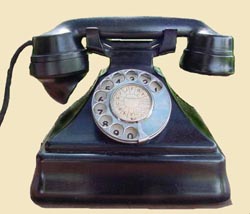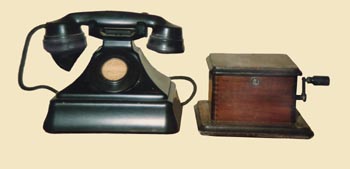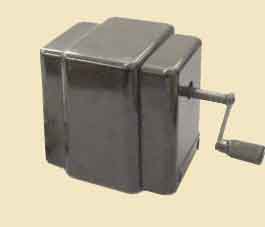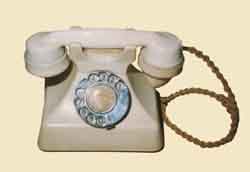 Type
232 Type
232 The Type 162 phone proved quite adequate for its purpose, but the
rather clumsy attached bellset with its external cord caused some maintenance
problems. By 1937 modifications had been designed that allowed the whole works
to be enclosed inside the cases. The modifications included a revised combined
anti-sidetone and induction coil, a redesigned cradle made from an early cellulose
plastic to make repairs to broken cradles less likely, a better non-sticking plunger
in the cradle, and removal of the external cord from the bell box to inside the
phone.
These changes, though not major, turned the phone into a good reliable instrument.
Some companies produced equivalent one-piece models with slightly different
styling. Siemens still produced their Neophone with a case that was lower but
more angular, and GEC produced the Gecophone in a more rounded form (see below).
Other companies produced the 232 for the various Post Office administrations
as well. In Australia, AWA (Amalgamated Wireless Australasia Ltd ) started production
in 1934. Initially they used some parts imported from Siemens in Britain, but
gradually AWA, TMC and STC were able to produce most of Australia's telephone
needs.

The phones could be adapted to auto, CB or magneto use. At left is a magneto
version with a small magneto in a separate wooden box. Even the wooden box was
eventually replaced by an art deco-style bakelite box.
The demand for the phones was high, and so was the price. Some subscribers
found they could buy in a phone from Britain and it would work on the Australian
system. This was tolerated due to a shortage of phones, but in 1942 the PMG
announced that it would purchase these phones back from their owners and replace
them with the 232. The purchased phone had to be in good condition , and had
to be replaced because of an exchange upgrade (manual to auto) or because the
subscriber was upgrading to a colored phone from the PMG. The purchased phones
could be refurbished and reused. In this way the Neophone and Gecophone and
a couple of others joined the ranks of PMG phones, albeit temporarily.

The replacement generator in its bakelite case. Eventually
there were around 300,000 of the 232 issued, and they were still being taken out
of service into the 1980s. Long line models, Type 251AT and 252CBT were
also available. 
Gecophone. The softer lines contrasted with the angular appearance
of the Neophone, shown below. 
Neophone. Note the higher base to accommodate the
internal bells.
 To
300 Series To
300 Series
 To
Tele 162 To
Tele 162
 To
QuickFind To
QuickFind
 If you have reached this page through a Search Engine, this will take you to the front page of the website If you have reached this page through a Search Engine, this will take you to the front page of the website
|